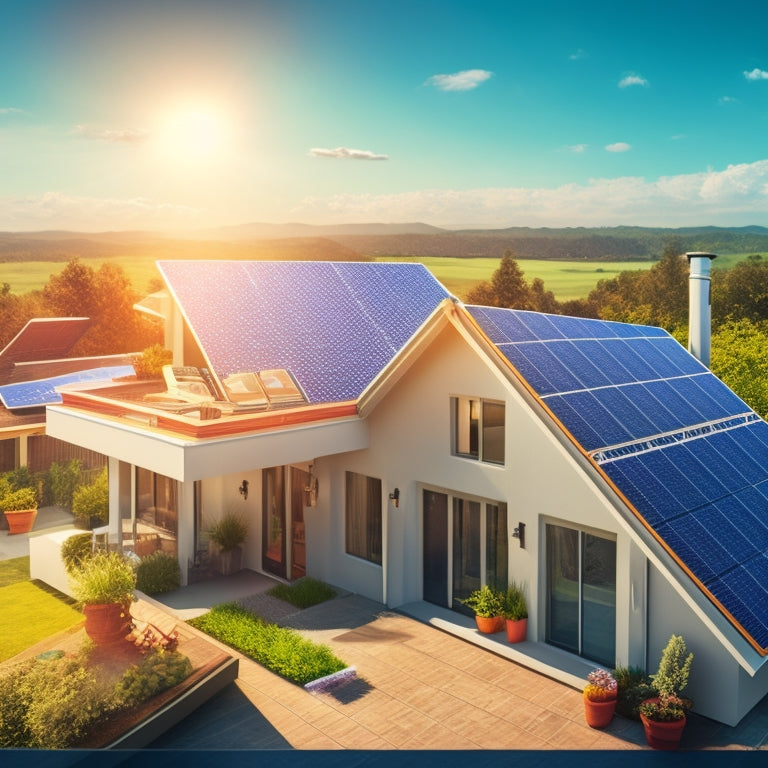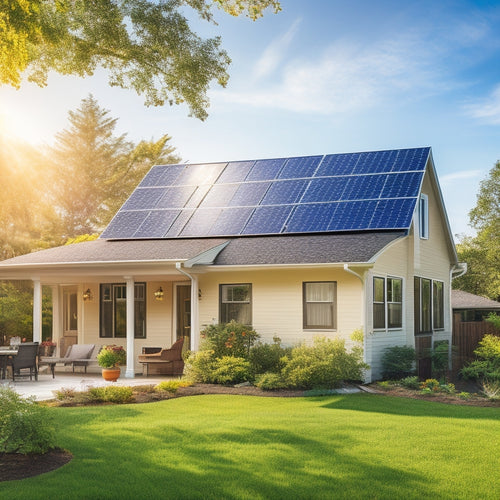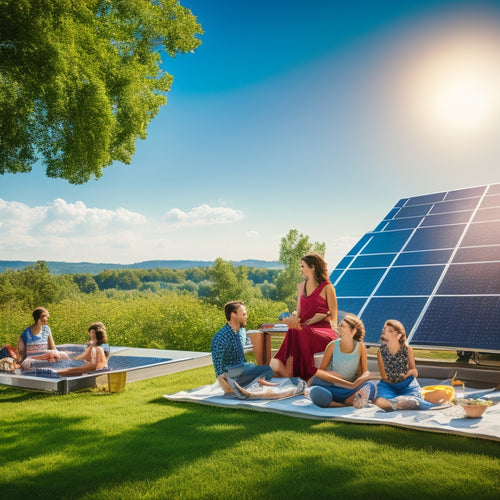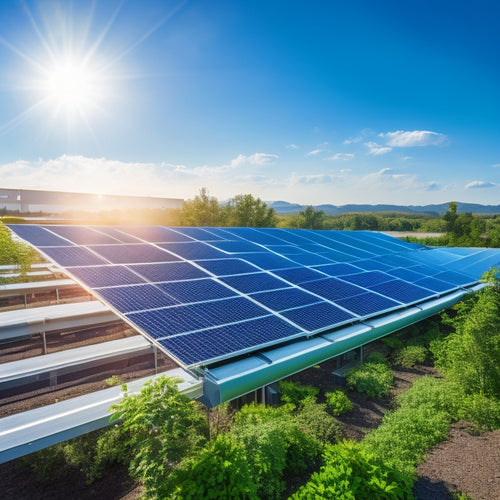
Key Factors in the Cost of Home Solar Panel Systems
Share
When buying a home solar panel system, you'll need to evaluate several key factors that affect the overall cost. The system's size and complexity, panel type and quality, and installation company and labor costs all play a significant role. Additionally, your roof's size and condition, local building codes and permits, inverter type and efficiency, battery backup and storage, mounting and tracking systems, location and climate factors, and available incentives and rebates can all impact the final price tag. As you maneuver through these factors, you'll get a clearer illustration of what to expect from your investment and how to optimize your system's performance.
Key Takeaways
- System size and complexity, including panel orientation and shading analysis, significantly impact the overall cost of a home solar panel system.
- The type and quality of solar panels, including durability, efficiency ratings, and manufacturer reputation, affect the system's cost and performance.
- Installation company expertise, labor costs, and project timelines influence the final cost, with skilled installers ensuring efficient installation and optimal system performance.
- Roof size and condition, including orientation, size, and shading, impact the system's effectiveness and cost, with larger roofs providing more space for panels.
- Local building codes, permits, and incentives, including compliance costs and zoning regulations, add to the overall expense of a home solar panel system.
System Size and Complexity
When it comes to determining the cost of a home solar panel system, one of the key factors to evaluate is the system size and complexity.
You'll need to contemplate how much energy you want to generate and how much space you have available for the panels. A larger system will generally cost more, but it will also provide more power.
System orientation is also essential. You'll want to position your panels to maximize energy production, considering the direction your roof faces and any shading from trees or buildings.
A shading analysis will help identify areas where energy production may be reduced, allowing you to enhance panel placement.
The complexity of the system also plays a significant role in determining cost. More complex systems, such as those with multiple inverters or tracking systems, will be more expensive.
However, they may also provide more efficient energy production and greater flexibility. By carefully evaluating your energy needs and system requirements, you can determine the best system size and complexity for your home solar panel system.
Type and Quality of Panels
You'll have several options to assess when selecting the type and quality of panels for your home solar panel system. The type of panel you choose will greatly impact the overall cost of your system.
Monocrystalline, polycrystalline, and thin-film panels are the most common types, each with its own advantages and disadvantages. Monocrystalline panels offer high energy output but are more expensive, while polycrystalline panels provide a lower energy output at a lower cost. Thin-film panels are the most budget-friendly option but have a lower energy output.
When evaluating panel quality, consider panel durability, which affects the system's overall lifespan and energy output. High-quality panels with a longer warranty (25 years or more) will generally cost more but provide better performance and durability.
Look for panels with high-efficiency ratings (above 20%) and a low temperature coefficient to guarantee peak energy output in various weather conditions. Additionally, check the manufacturer's reputation, certifications, and testing standards to confirm you're getting a reliable product.
Installation Company and Labor
When you're investing in a home solar panel system, you'll want to verify the installation company you choose has experienced professionals who can get the job done efficiently and effectively.
The knowledge of the installer matters, as it directly impacts the quality of the installation and the system's overall performance.
Labor costs can vary greatly depending on the company, location, and complexity of the installation, so it's crucial to research and compare quotes from different providers.
Installer Expertise Matters
How vital is the role of a skilled installation company in determining the overall cost of your home solar panel system? The answer is essential. A skilled installation company can greatly impact the overall cost of your system.
| Installer Qualification | Benefits | Cost Impact |
|---|---|---|
| Installer Training | Improved system design, efficient installation | Lower cost due to reduced labor hours |
| Certification Programs | Compliance with industry standards, increased safety | Lower cost due to reduced risk of rework |
| Experience with Local Regulations | Streamlined permitting process, reduced delays | Lower cost due to reduced administrative overhead |
| Manufacturer Certification | Optimized system performance, extended warranties | Higher cost due to premium products and services |
When you choose an installation company with skilled professionals, you can expect a more efficient installation process, reduced labor hours, and lower costs. These installers have undergone rigorous training, possess relevant certifications, and have experience working with local regulations. While a manufacturer-certified installer may come at a higher cost, the benefits of optimized system performance and extended warranties can outweigh the additional expense.
Labor Costs Vary
The installation company's labor costs greatly impact the overall expense of your home solar panel system, and these costs can vary widely depending on several factors.
As you consider different installation companies, it's crucial to understand what drives these labor costs.
-
Wage fluctuations: Labor costs are directly tied to the hourly wages of the installation team. Companies with higher-paid workers will charge more for their services.
-
Project timelines: The longer the project takes, the more labor costs you'll incur. Companies that work efficiently and complete projects quickly can offer more competitive pricing.
-
Location and travel time: Installation companies with shorter travel distances or those located in areas with lower costs of living may offer lower labor costs.
- Company overhead and profit margins: The installation company's overhead, profit margins, and administrative costs are also factored into labor costs.
Understanding these factors will help you make an informed decision when selecting an installation company for your home solar panel system.
Quality of Workmanship
You expect a high-quality installation from the company you hire, and it's essential to evaluate the quality of workmanship before making a final decision. A reputable installation company will have established workmanship standards, guaranteeing that their installation techniques meet industry benchmarks.
Look for companies with strong quality assurance processes in place, including project management systems that oversee every stage of the installation. Safety protocols should also be a top priority, protecting both the installation team and your property.
Material sourcing is another vital aspect to take into account. A good installation company will only use high-quality components, sourced from reputable suppliers.
Check customer feedback and reviews to get a sense of the company's reputation and level of customer satisfaction. Additionally, verify the company offers all-encompassing warranty coverage, providing peace of mind in case anything goes wrong.
Roof Size and Condition
Frequently, homeowners overlook the significance of roof size and condition when considering a home solar panel system.
However, these factors can greatly impact the overall cost and efficiency of your system.
When evaluating your roof's suitability for solar panels, you should consider the following key factors:
-
Roof orientation: The direction your roof faces can affect the amount of sunlight your solar panels receive. South-facing roofs receive the most sunlight, making them ideal for solar panels.
-
Roof size: A larger roof provides more space for solar panels, allowing you to generate more power. However, a larger roof may also require more panels, increasing the overall cost.
-
Shading analysis: Shading from trees, buildings, or other obstructions can reduce the efficiency of your solar panels. A thorough shading analysis can help you determine the best placement for your panels.
- Roof condition and age: An older or damaged roof may need to be replaced before installing solar panels, adding to the overall cost of the system.
Local Building Codes and Permits
One essential aspect of installing a home solar panel system is guaranteeing compliance with local building codes and permits.
You'll need to research and comply with zoning regulations, which vary by jurisdiction, to assure your system meets specific requirements. The permit process typically involves submitting plans and paying fees, which can add to your overall cost.
Safety standards and inspection requirements must also be met to guarantee a secure and efficient system.
Additionally, you may be eligible for local incentives, such as rebates or tax credits, for installing a solar panel system.
However, these incentives often come with specific requirements, such as meeting certain environmental impact standards.
The installation timeline can be affected by the permit process and building inspections, which may delay your project.
As a homeowner, it's your responsibility to guarantee compliance with local regulations, which can result in added compliance costs.
Be prepared to factor these costs into your overall budget to avoid unexpected expenses.
Inverter Type and Efficiency
When selecting a home solar panel system, you'll encounter two main inverter types: string inverters and microinverters.
You'll need to evaluate the advantages of string inverters, such as their lower upfront cost and ease of installation, as well as the benefits of microinverters, including their ability to optimize energy production at the individual panel level.
The efficiency rating of your chosen inverter will also impact your system's overall performance and cost.
String Inverter Advantages
String inverters, a popular choice for home solar panel systems, boast several advantages that make them an attractive option for homeowners. When considering the cost of a home solar panel system, it's crucial to weigh the benefits of string inverters.
-
String inverter reliability: String inverters are known for their high reliability, with a mean time between failures (MTBF) of up to 200,000 hours. This translates to fewer maintenance costs and a longer lifespan for your system.
-
String inverter cost effectiveness: String inverters are generally more cost-effective than other inverter types, making them an attractive option for homeowners on a budget.
-
Simplified installation and monitoring: String inverters have fewer components than other inverter types, making installation and monitoring easier and more straightforward.
- High efficiency: String inverters can achieve efficiencies of up to 98.5%, ensuring that you get the most power out of your solar panel system.
Microinverter Benefits Analysis
Your home solar panel system's efficiency hinges on the inverter type, and microinverters offer a unique set of benefits that make them an attractive alternative to string inverters.
Microinverters are installed under each solar panel, allowing for individual panel monitoring and enhancement. This setup enables you to pinpoint and troubleshoot issues more easily, reducing downtime and increasing overall system efficiency.
One of the significant microinverter advantages is their ability to maximize energy production. Since each panel operates independently, shading or malfunctioning panels won't affect the entire system's performance.
This design also enables you to add or remove panels as needed, providing flexibility and scalability.
Microinverters typically have a longer lifespan than string inverters, with some manufacturers offering up to 25-year warranties.
This extended microinverter lifespan means you'll enjoy a longer period of ideal performance and reduced maintenance costs.
Additionally, microinverters often come with built-in monitoring capabilities, providing you with real-time data on your system's performance.
Efficiency Rating Impact
Each component in a home solar panel system plays a critical role in determining its overall efficiency, and the inverter type is no exception. The inverter is responsible for converting the DC power generated by your solar panels into AC power that can be used in your home. The efficiency of this energy conversion process directly impacts the overall solar panel efficiency of your system.
When it comes to inverter efficiency, you'll often see ratings such as 96%, 98%, or even 99%. But what does this mean for you? Here are a few key points to contemplate:
-
Higher inverter efficiency means more power: A higher efficiency rating means more of the DC power generated by your solar panels is converted into usable AC power.
-
Inverter type affects efficiency: String inverters, microinverters, and power optimizers each have their own efficiency characteristics. Microinverters, for example, tend to have higher efficiency ratings than string inverters.
-
Efficiency varies by manufacturer: Different manufacturers offer inverters with varying efficiency ratings, so it's crucial to research and compare options.
- Efficiency impacts system cost: While a more efficient inverter may cost more upfront, it can lead to long-term savings by maximizing your energy production.
When evaluating inverter options, reflect on the efficiency rating and how it will impact your system's overall performance and cost.
Battery Backup and Storage
Many homeowners investing in home solar panel systems consider adding a battery backup and storage system to maximize their energy independence. This addition provides a reliable source of power during grid outages and reduces your reliance on the grid.
With a battery backup, you can store excess energy generated by your solar panels during the day for use at night or during power outages. This not only increases your energy independence but also provides cost savings by reducing your energy consumption from the grid.
In addition, battery storage helps reduce your environmental impact by decreasing your carbon footprint. When selecting a battery backup system, consider factors like battery lifespan, maintenance requirements, and performance monitoring capabilities.
Some systems also offer installation incentives, so be sure to investigate those options. Moreover, look for systems that offer seamless grid connectivity, ensuring a smooth shift between grid power and battery power.
Mounting and Tracking Systems
One essential aspect of a home solar panel system is the mounting and tracking system, which plays an important role in maximizing energy output.
You'll need to decide on the best mounting techniques for your system, considering factors like roof type, size, and orientation.
-
Roof-mounted systems: These are the most common type, attached directly to your roof.
-
Ground-mounted systems: These are freestanding and can be installed anywhere on your property.
-
Tracking systems: These adjust the angle of your panels to follow the sun's movement, enhancing energy output by up to 45%.
- Dual-axis tracking systems: These advanced systems track the sun's movement in both altitude and azimuth, further maximizing energy production.
When evaluating tracking benefits, you'll want to weigh the added cost against the increased energy output.
Tracking systems can be more expensive, but they can also considerably enhance your system's overall performance.
Location and Climate Factors
About 75% of a solar panel system's energy output is determined by its location and climate. You'll want to evaluate the weather patterns in your area, including the amount of sunlight your roof receives daily. This geographic orientation affects your energy consumption and, subsequently, your solar panel system's performance.
A shading analysis is vital to identify potential obstructions, such as trees or nearby buildings, that could impact your system's energy output. Installation timelines may also be influenced by local weather conditions, so it's important to plan accordingly.
Additionally, local solar policies and solar incentives can greatly impact the cost of your system.
When evaluating the environmental impact of your solar panel system, contemplate your location's climate and how it affects the system's overall efficiency. For instance, areas with high temperatures or extreme weather conditions may require more durable systems.
Understanding these location and climate factors will help you make informed decisions about your solar panel system, ensuring you maximize its energy output while minimizing its cost.
Frequently Asked Questions
Can I Install Solar Panels on a Metal or Clay Tile Roof?
You'll need to evaluate installation factors and roof compatibility before putting solar panels on a metal or clay tile roof; verify your roof's structure can support the added weight and that the panels are securely fastened to withstand weather conditions.
Do Solar Panels Work During a Power Outage?
You'll need a battery backup system to keep your solar panels working during a power outage, as standard systems shut down for safety reasons, but with the right setup, you can enjoy uninterrupted power and maximize solar panel efficiency.
Can I Add Solar Panels to an Existing System Later?
You can expand your existing solar panel system, but you'll need to verify system compatibility, considering factors like panel type, voltage, and inverter capacity, to seamlessly integrate new panels into your solar panel expansion.
How Long Does It Take to Install a Solar Panel System?
You'll be utilizing solar power in no time, as the average solar panel system installation takes around 3-5 days, with the installation process involving a thorough assessment, permits, and a swift installation timeline that gets you generating electricity quickly.
Are There Any Maintenance Costs for Solar Panels?
You'll be relieved to know that solar panel upkeep is minimal; you'll need to clean them every 6-12 months, and inspect them annually for loose connections, damaged panels, or worn parts, ensuring ideal energy harvesting with minimal maintenance frequency.
Conclusion
You've made it to the end of this solar panel cost breakdown, and you're probably thinking, "Wow, I had no idea it was so complicated!" And you're right, it is. But don't worry, now that you know the key factors affecting the cost of home solar panel systems, you'll be well-equipped to steer through the process like a pro. Just remember, it's not just about slapping some panels on your roof and calling it a day - there's a lot more to it than that.
Related Posts
-

How to Finance Home Solar Panels
Financing home solar panels offers several strategies to lighten your initial costs while maximizing long-term benefi...
-

Solar Power Savings for Environmentally Aware Consumers
Switching to solar power lets you drastically cut your carbon footprint while saving money in the long run. Each kilo...
-

Solar Energy Efficiency Improvements for Businesses
Improving solar energy efficiency for your business can lead to considerable cost savings and enhance your sustainabi...


